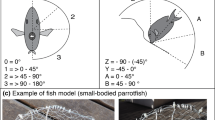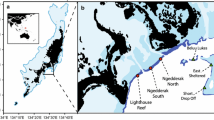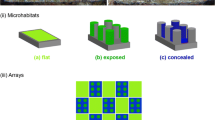Abstract
Extreme population fluctuations, or outbreaks, are driven by interacting processes that are often more complex than isolated changes in consumer or resource control. Blooms of the macroalga Caulerpa sertularioides in the eastern tropical Pacific overgrew and killed reef-building corals, with blooms onto reefs corresponding to cool La Niña phases of inter-decadal fluctuations of the El Niño–Southern Oscillation. We quantified factors responsible for the maintenance of C. sertularioides patches in off-reef areas, namely an associational mutualism with an epiphytic cyanobacteria (Lyngbya majuscula), coupled with spatial refuges at the scales of individual thalli and habitat. Maintenance of near reef algal populations with a strong response to nutrient addition showed that these populations were primed to bloom onto reefs in response to enhanced nutrient delivery, such as those potentially associated with La Niña conditions. However, our experiments demonstrated that no single factor related to consumer or resource control was likely to stimulate bloom formation in isolation. Rather, we propose a novel model of reef bloom formation where off-reef blooms are sustained by processes reducing consumer control, and then bloom onto reefs through an interaction between increased allochthonous nutrient input and an uncoupling of consumer control by an association with epiphytic cyanobacteria.






Similar content being viewed by others
References
Burkepile DE, Hay ME (2006) Herbivore vs. nutrient control of marine primary producers: context-dependent effects. Ecology 87:3128–3139
Carpenter RC (1986) Partitioning herbivory and its effects on coral reef algal communities. Ecol Monogr 56:345–363
Ceccarelli D, Jones G, McCook L (2001) Territorial damselfishes as determinants of the structure of benthic communities on coral reefs. Oceanogr Mar Biol Annu Rev 39:355–389
D’Croz L, O’Dea A (2007) Variability in upwelling along the Pacific shelf of Panama and implications for the distribution of nutrients and chlorophyll. Estuar Coast Shelf Sci 73:325–340
Dwyer G, Dushoff J, Yee SH (2004) The combined effects of pathogens and predators on insect outbreaks. Nature 430:341–345
Estes JA, Duggins DO (1995) Sea otters and kelp forests in Alaska: generality and variation in a community ecological paradigm. Ecol Monogr 65:75–100
Fernández C, Cortés J (2005) Caulerpa sertularioides, a green alga spreading aggressively over coral reef communities in Culebra Bay, North Pacific of Costa Rica. Coral Reefs 24:10
Fong P, Smith TB, Wartian MJ (2006) Epiphytic cyanobacteria maintain shifts to macroalgal dominance on coral reefs following ENSO disturbance. Ecology 87:1162–1168
Glynn PW (1988) El Nino-southern oscillation 1982–1983: nearshore population, community, and ecosystem responses. Annu Rev Ecol Syst 19:309–345
Glynn PW (2004) High complexity food webs in low-diversity eastern Pacific reef-coral communities. Ecosystems 7:358–367
Glynn PW, Maté JL (1997) Field guide to the coral reefs of Panamá. In: Proceedings of the 8th International Coral Reef Symposium, Panama, vol 1, pp 145–166
Halpern BS, Cottenie K, Broitman BR (2006) Strong top-down control in Southern California kelp forest ecosystems. Science 312:1230–1232
Harvell CD, Mitchell C, Ward J, Altizer S, Dobson A, Ostfeld R, Samuel M (2002) Climate warming and disease risks for terrestrial and marine biota. Science 296:2158–2168
Hay ME (1981a) Spatial patterns of grazing intensity on a Caribbean barrier reef: herbivory and algal distribution. Aquat Bot 11:97–109
Hay ME (1981b) The functional morphology of turf-forming seaweeds: persistence in stressful marine habitats. Ecology 62:739–750
Holling CS (1973) Resilience and the stability of ecological systems. Annu Rev Ecol Syst 4:1–23
Hughes TP (1994) Catastrophes, phase shifts, and large-scale degradation of a Caribbean coral reef. Science 265:1547–1551
Hughes TP, Rodrigues MJ, Bellwood DR, Ceccarelli D, Hoegh-Guldberg O, McCook L, Moltschaniwskyj N, Pratchett MS, Steneck RS, Willis B (2007) Phase shifts, herbivory, and the resilience of coral reefs to climate change. Curr Biol 17:360–365
Jones K (1990) Aerobic nitrogen fixation by Lyngbya sp., a marine tropical cyanobacterium. Br Phycol J 25:287–289
Lapointe B (1997) Nutrient thresholds for bottom-up control of macroalgal blooms on coral reefs in Jamaica and southeast Florida. Limnol Oceanogr 42:1119–1131
Mack RN, Simberloff D, Mark Lonsdale W, Evans H, Clout M, Bazzaz FA (2000) Biotic invasions: causes, epidemiology, global consequences, and control. Ecol Appl 10:689–710
McCook LJ (1999) Macroalgae, nutrients and phase shifts on coral reefs: scientific issues and management consequences for the Great Barrier Reef. Coral Reefs 18:357–367
Menge B, Lubchenco J, Bracken M, Chan F, Foley M, Freidenburg T, Gaines S, Hudson G, Krenz C, Leslie H, Menge D, Russel R, Webster M (2003) Coastal oceanography sets the pace of rocky intertidal community dynamics. Proc Natl Acad Sci 100:12229–12234
Nagle DG, Paul VJ (1999) Production of secondary metabolites by filamentous tropical marine cyanobacteria: ecological functions of the compounds. J Phycol 35:1412–1421
NOAA (2006) NOAA El Niño page. http://www.cpc.noaa.gov/products/analysis/monitoring/ensostuff/ensoyears.shtml. Accessed 5 May 2006
NOAA (2008) NOAA El Niño page. http://www.elnino.noaa.gov. Accessed 13 Mar 2008
Paine RT (1969) A note on trophic complexity and community stability. Am Nat 103:91–93
Paul VJ, Nelson SG, Sanger HR (1990) Feeding preferences of adult and juvenile rabbitfish Siganus argenteus in relation to chemical defenses of tropical seaweeds. Mar Ecol Prog Ser 60:23–34
Paul VJ, Hay ME (1986) Seaweed susceptibility to herbivory: chemical and morphological correlates. Mar Ecol Prog Ser 33:255–264
Podestá GP, Glynn PW (1997) Sea surface temperature variability in Panama and Galapagos: extreme temperatures causing coral bleaching. J Geophys Res C Oceans 102:15749–15759
Polis GA, Power ME, Huxel GR (2004) Food webs at the landscape level. University of Chicago Press, Chicago
Rilov G, Benayahu Y, Gasith A (2004) Prolonged lag in population outbreak of an invasive mussel: a shifting-habitat model. Biol Invasions 6:347–364
Singleton GR, Brown PR, Pech RP, Jacob J, Mutze GJ, Krebs CJ (2005) One hundred years of eruption of house mice in Australia—a natural biological curio. Biol J Linn Soc 84:617–627
Smith TB (2005) The dynamics of coral reef algae in an upwelling system. Ph.D. thesis, University of Miami, Miami
Smith TB (2008) Temperature effects on herbivory for an Indo-Pacific parrotfish in Panamá: implications for coral-algal competition. Coral Reefs 27:397–405
Smith CM, Walters LJ (1999) Fragmentation as a strategy for Caulerpa species: fates of fragments and implications for management of an invasive weed. Mar Ecol 20:307–319
Smith JE, Runcie JW, Smith CM (2005) Characterization of a large-scale ephemeral bloom on the green alga Cladophora sericea on the coral reefs of West Maui, Hawai’i. Mar Ecol Prog Ser 302:77–91
Stireman JO III, Dyer LA, Janzen DH, Singer MS, Lill JT, Marquis RJ, Ricklefs RE, Gentry GL, Hallwachs W, Coley PD, Barone JA, Greeney HF, Connahs H, Barbosa P, Morais HC, Diniz IR (2005) Climatic unpredictability and parasitism of caterpillars: implications of global warming. Proc Natl Acad Sci 102:17384–17387
Vinueza LR, Branch GM, Branch ML, Bustamante RH (2006) Top-down herbivory and bottom-up El Niño; effects of Galápagos rocky-shore communities. Ecol Monogr 76:111–131
Williams ID, Polunin NVC (2001) Large-scale associations between macroalgal cover and grazer biomass on mid-depth reefs in the Caribbean. Coral Reefs 19:358–366
Wright JT, Davis AR (2006) Demographic feedback between clonal growth and fragmentation in an invasive seaweed. Ecology 87:1744–1754
Acknowledgments
Funding from this study was provided by NSF Biological Oceanography Program (grant OCE-0002317 to P. Glynn and P. Fong) and a Smithsonian Tropical Research Institute (STRI) Pre-Doctoral Fellowship to T. B. Smith. We thank P. Glynn for his advice and encouragement on all aspects of this research. We are ever grateful for the field assistance and stimulating input of C. Hueerkamp, A. Romanski, D. Manzello, and R. Muthukrisnan, and the analytical advice of M. Brandt. We would also like to express our gratitude for the enthusiastic logistical support of the staff of STRI and the R. V. Urraca.
Author information
Authors and Affiliations
Corresponding author
Additional information
Communicated by Martin Attrill.
Electronic supplementary material
Below is the link to the electronic supplementary material.
Rights and permissions
About this article
Cite this article
Smith, T.B., Fong, P., Kennison, R. et al. Spatial refuges and associational defenses promote harmful blooms of the alga Caulerpa sertularioides onto coral reefs. Oecologia 164, 1039–1048 (2010). https://doi.org/10.1007/s00442-010-1698-x
Received:
Accepted:
Published:
Issue Date:
DOI: https://doi.org/10.1007/s00442-010-1698-x




